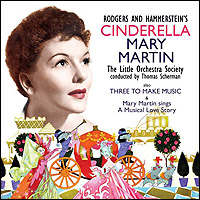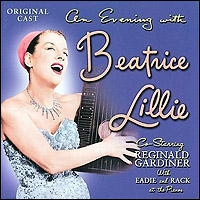
*
 |
Somewhere in the mid-1950s, Mary Martin seemed to turn from a saucy Southern songbird into someone decidedly more sedate (if sugar-sweet). This transformation can be sampled in the new release from Sepia, "Mary Martin: Cinderella/Three to Make Music." While waiting for The Sound of Music to be formulated, Mary — more famous than ever, buoyed by the success of the record-breaking 1955 telecast of "Peter Pan" — embarked on an 87-city concert tour beginning in September 1958. Two shows a day: a child-oriented matinee, "Magic with Mary Martin," and "Music with Mary Martin" in the evening. The children's show consisted mostly of two sections. In one, Mary did a kid-friendly mini-version of Rodgers & Hammerstein's 1957 TV musical "Cinderella"; the other part was Three to Make Music, by Mary Rodgers and Linda Melnick (the daughters of Richard Rodgers). The latter was a concert piece devised for The Little Orchestra Society, a New York-based group founded and led by Thomas Scherman. Mary heard it, liked it, and incorporated it into her upcoming tour (taking along the clown featured in the piece, Dirk Sanders). The tour culminated with NBC broadcasting both "Magic with Mary Martin," and "Music with Mary Martin" separately, as one-hour specials, on March 29, 1959.
Martin's versions of Cinderella and "Three to Make Music," with The Little Orchestra Society and Mr. Sanders, were recorded together for an LP and released by RCA in 1959. This makes up about half of the Sepia CD. Martin was performing these for children, as stated, and they feature the sedately sugar-sweet Mary referred to above. Cinderella is performed interactively, more or less. Mary's Peter Pan had called out to her audience for help in saving poor Tink, as some readers might recall; here, she asked the kids to help steer the Cinderella tale to a happy ending. (Mary also seems to assume that her entire audience is made up of girls; at least, she asks her listeners if they are all pretending to be Cinderella.) This is, alas, a somewhat reduced Cinderella. I, for one, was looking forward to hearing Mary's rendition of the "Stepsister's Lament," at which she could be expected to excel; but no, she doesn't sing that one. She does give us various character voices, though.
"Three to Make Music" is, perhaps, the surprise of the CD. The work of Mary Rodgers is known to readers of this column, highlighted by the music for Once upon a Mattress. Here, though, she is writing the words and lyrics; the music comes from her sister Linda. The material can't help but be of some interest. The three it takes to make music, by the way, are "the man who writes it, the men who play it, and folks for whom it is played." This from one of Broadway's early female composers. Mary also explains that "there are lots of different kinds of composers, happy ones, sad ones, modern ones, bad ones." And this from someone with an intimate relationship with two of America's most important composers of the century. (For that matter, both have passed on their father's composer genes to a third generation: Mary's son is Adam Guettel, Linda's is Peter Melnick.) The Cinderella orchestrations seem to be pulled from Russell Bennett's originals. While the others go uncredited, I found a notation in Bennett's personal ledger indicating that he billed Tom Scherman for 152 pages of "Three to Make Music" in June 1958, at which point the piece was presumably introduced by the Little Orchestra Society (which is where Martin must have heard it). A few months later Bennett put in a bill for "Mary Martin Evening/Overture," which seems to be for the touring "Music with Mary Martin." This one apparently went unrecorded, whereabouts unknown.
The Sepia CD also includes "Mary Martin Sings A Musical Love Story." This was a 1957 album released on Disneyland Records. The 25-minute album consists of two medleys, encompassing 17 pop songs; Johnny Lesko, Mary's favorite accompanist of her later years, serves as conductor. What instantly stands out is that this Mary, circa 1957, is the aforementioned Southern songbird. Not saucy — she was 44 at the time — but she is singing here like she did in the earlier days, joyful and bordering on the jazzy. The first medley builds to an extended (three-minute) rendition of Kern and Hammerstein's "The Song Is You," and it is very nice indeed.
The CD ends with two 1956 singles. One is yet another rendition of "My Heart Belongs to Daddy," the 1938 Cole Porter tune which made Mary famous (here in a slightly cleaned-up version); the other is a real rarity, the Bushkin-Kanin "Boy Wanted." Sounds unfamiliar, no? Remember the Hallmark television version of "Born Yesterday?" Me neither. Paul Douglas, who created Harry Brock on stage but did not make the film version, recreated his role; Judy Holliday's role of Billie Dawn was played by — who — Mary??? Yep. That's what it says. Playwright Garson Kanin wrote a song for the endtitles, with a composer unknown to me named Joe Bushkin, and here we have it. "Boy Wanted," delivered with a Southern-fried drawl, and not bad.
 |
And why not mix Mary Martin with Beatrice Lillie? Lillie (1894-1989) was one of the unique talents of the Broadway/West End musical theatre of the second quarter of the last century. Revues were her métier, with folks like Dietz and Schwartz, Rodgers and Hart, Vincent Youmans, Cole Porter and Noel Coward providing material to fit. Her greatest successes came in the '30s and '40s. With the arrival of television in the post-World War II era, the days of the full-scale Broadway revue were suddenly gone; why go to theatre when you could see a fresh and topical new star-studded revue every week on TV with the likes of Milton Berle, Sid Caesar and their ilk? Lillie, whose droll and sophisticated style was perhaps too specialized for the small screen, regrouped with a not-quite-one-woman revue, An Evening with Beatrice Lillie. Not-quite-one-woman in that Lillie was accompanied by Reginald Gardiner, an accomplished comedian in his own right, as well as two character ladies; a singer; and the husband/wife duo pianists known as Eadie and Rack. An Evening with Beatrice Lillie came into the Booth on Oct. 2, 1952 and was an instant hit. (My book "Opening Night on Broadway" — long out-of-print, alas — includes a comparative summary of the critical reception of about 300 musicals that opened from 1943 to 1964. By my calculation, only eight shows received unanimous raves from the major first-night newspaper critics: Brigadoon, Guys and Dolls, How to Succeed in Business without Really Trying, The Music Man, My Fair Lady, South Pacific, Wonderful Town — and An Evening with Beatrice Lillie.)
Following an eight-month run and a special Tony Award, Lillie took her revue to London, where Gardiner was replaced by an up-and-coming performer named Leslie Bricusse. Yes, the same Leslie Bricusse.
At any rate, Sepia has given us the original cast album of An Evening with Beatrice Lillie, coupled with selections from a 1958 LP the star recorded in London. An Evening includes such selections as Rodgers & Hart's "Rhythm," a wonderfully clever melange introduced by Bea in the 1933 London revue Please! and repeated three years later in The Show Is On; Dietz and Schwartz's "Nanette," from The Band Wagon; Coward's "Weary of It All," "Piccolo Marina" and "The Party's Over Now"; and the Lillie specialty "There Are Fairies at the Bottom of My Garden." Also on hand is a specialty of Mr. Gardiner's, his monologue about "Trains" (presented on two tracks).
We don't get a complete picture of Lillie's talents; there are some earlier and livelier recordings floating around with the younger Lillie. But Sepia's CD will give today's listener a good idea of what Lillie sounded like, around the age of 60. A very special talent, and one not to be overlooked.
(Steven Suskin is author of the recently released updated and expanded Fourth Edition of "Show Tunes" as well as "The Sound of Broadway Music: A Book of Orchestrators and Orchestrations," "Second Act Trouble," and the "Opening Night on Broadway" books. He can be reached at [email protected])










